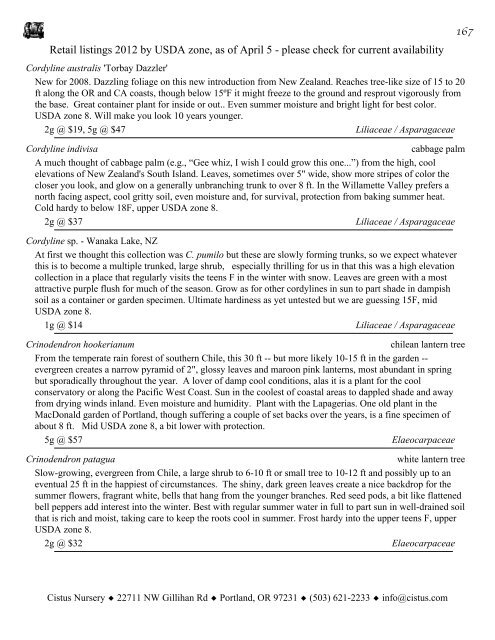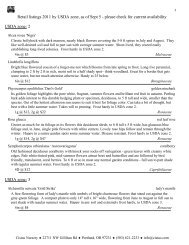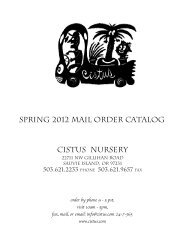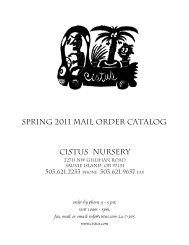1 Retail listings 2012 by USDA zone, as of April 5 ... - Cistus Nursery
1 Retail listings 2012 by USDA zone, as of April 5 ... - Cistus Nursery
1 Retail listings 2012 by USDA zone, as of April 5 ... - Cistus Nursery
You also want an ePaper? Increase the reach of your titles
YUMPU automatically turns print PDFs into web optimized ePapers that Google loves.
<strong>Retail</strong> <strong>listings</strong> <strong>2012</strong> <strong>by</strong> <strong>USDA</strong> <strong>zone</strong>, <strong>as</strong> <strong>of</strong> <strong>April</strong> 5 - ple<strong>as</strong>e check for current availability<br />
Cordyline australis 'Torbay Dazzler'<br />
New for 2008. Dazzling foliage on this new introduction from New Zealand. Reaches tree-like size <strong>of</strong> 15 to 20<br />
ft along the OR and CA co<strong>as</strong>ts, though below 15ºF it might freeze to the ground and resprout vigorously from<br />
the b<strong>as</strong>e. Great container plant for inside or out.. Even summer moisture and bright light for best color.<br />
<strong>USDA</strong> <strong>zone</strong> 8. Will make you look 10 years younger.<br />
2g @ $19, 5g @ $47 Liliaceae / Asparagaceae<br />
Cordyline indivisa cabbage palm<br />
A much thought <strong>of</strong> cabbage palm (e.g., “Gee whiz, I wish I could grow this one...”) from the high, cool<br />
elevations <strong>of</strong> New Zealand's South Island. Leaves, sometimes over 5" wide, show more stripes <strong>of</strong> color the<br />
closer you look, and glow on a generally unbranching trunk to over 8 ft. In the Willamette Valley prefers a<br />
north facing <strong>as</strong>pect, cool gritty soil, even moisture and, for survival, protection from baking summer heat.<br />
Cold hardy to below 18F, upper <strong>USDA</strong> <strong>zone</strong> 8.<br />
2g @ $37 Liliaceae / Asparagaceae<br />
Cordyline sp. - Wanaka Lake, NZ<br />
At first we thought this collection w<strong>as</strong> C. pumilo but these are slowly forming trunks, so we expect whatever<br />
this is to become a multiple trunked, large shrub, especially thrilling for us in that this w<strong>as</strong> a high elevation<br />
collection in a place that regularly visits the teens F in the winter with snow. Leaves are green with a most<br />
attractive purple flush for much <strong>of</strong> the se<strong>as</strong>on. Grow <strong>as</strong> for other cordylines in sun to part shade in dampish<br />
soil <strong>as</strong> a container or garden specimen. Ultimate hardiness <strong>as</strong> yet untested but we are guessing 15F, mid<br />
<strong>USDA</strong> <strong>zone</strong> 8.<br />
1g @ $14 Liliaceae / Asparagaceae<br />
Crinodendron hookerianum chilean lantern tree<br />
From the temperate rain forest <strong>of</strong> southern Chile, this 30 ft -- but more likely 10-15 ft in the garden -evergreen<br />
creates a narrow pyramid <strong>of</strong> 2", glossy leaves and maroon pink lanterns, most abundant in spring<br />
but sporadically throughout the year. A lover <strong>of</strong> damp cool conditions, al<strong>as</strong> it is a plant for the cool<br />
conservatory or along the Pacific West Co<strong>as</strong>t. Sun in the coolest <strong>of</strong> co<strong>as</strong>tal are<strong>as</strong> to dappled shade and away<br />
from drying winds inland. Even moisture and humidity. Plant with the Lapageri<strong>as</strong>. One old plant in the<br />
MacDonald garden <strong>of</strong> Portland, though suffering a couple <strong>of</strong> set backs over the years, is a fine specimen <strong>of</strong><br />
about 8 ft. Mid <strong>USDA</strong> <strong>zone</strong> 8, a bit lower with protection.<br />
5g @ $57 Elaeocarpaceae<br />
Crinodendron patagua white lantern tree<br />
Slow-growing, evergreen from Chile, a large shrub to 6-10 ft or small tree to 10-12 ft and possibly up to an<br />
eventual 25 ft in the happiest <strong>of</strong> circumstances. The shiny, dark green leaves create a nice backdrop for the<br />
summer flowers, fragrant white, bells that hang from the younger branches. Red seed pods, a bit like flattened<br />
bell peppers add interest into the winter. Best with regular summer water in full to part sun in well-drained soil<br />
that is rich and moist, taking care to keep the roots cool in summer. Frost hardy into the upper teens F, upper<br />
<strong>USDA</strong> <strong>zone</strong> 8.<br />
2g @ $32 Elaeocarpaceae<br />
<strong>Cistus</strong> <strong>Nursery</strong> ◆ 22711 NW Gillihan Rd ◆ Portland, OR 97231 ◆ (503) 621-2233 ◆ info@cistus.com<br />
167







